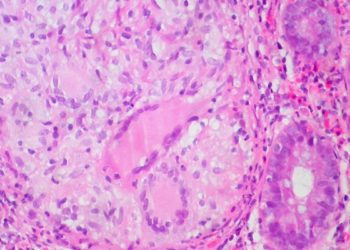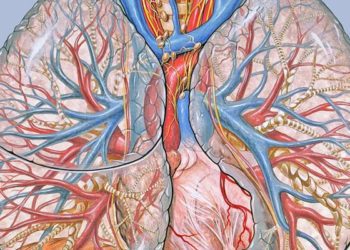2 Minute Medicine Rewind December 7, 2020
1. Hyoscine butylbromide and acetaminophen have comparable and significant analgesic effects for pediatric non-specific colicky abdominal pain.
Evidence Rating Level: 1 (Excellent)
Cases of pediatric abdominal pain are a daily occurrence in hospital emergency wards. However, current analgesic recommendations for pediatric abdominal pain are not being adhered to, with two-thirds of patients not receiving any analgesia, and approximately half still experiencing pain post-discharge. A potential factor for this is the lack of analgesic guidelines for non-specific abdominal pain, which comprises two-thirds of abdominal pain cases. Acetaminophen is widely used to treat a variety of painful conditions, but there is insufficient data to demonstrate its effectiveness for abdominal pain, Hyoscine butylbromide (HBB) is an oral antispasmodic medication that has some studies supporting its effectiveness. The current study was a randomized controlled trial to determine whether HBB had superior pain-relieving abilities compared to acetaminophen, for pediatric non-specific colicky abdominal pain. The study population consisted of 236 children ages 8-17 (mean±SD age was 12.4±3), with 120 patients given 10 mg of HBB and 116 given 15 mg/kg of acetaminophen. Each patient presented to a hospital in London, Ontario with a self-reported pain score of at least 40 mm on a 100 mm visual analogue scale (mean pain score was 60±18 mm for HBB, and 62±17 mm for acetaminophen). The primary outcome was pain score 80 minutes after administering the analgesic, to reflect the drugs’ peak action. Overall, the results showed no difference in pain score: For HBB, the mean score was 29±26 mm, while for acetaminophen, it was 30±29 mm. The adjusted difference between the groups was 1 mm (95% CI -7 to 7 mm). Furthermore, no significant differences were found for requirement of emergency analgesia, nor for adverse events and complications. In conclusion, HBB is not superior to acetaminophen for non-specific colicky pediatric abdominal pain, although both forms of analgesia can produce a clinically significant reduction in pain.
1. The association between major birth defects and cancer risk was present in children, adolescents, and adults, although the risk was lower in adults.
2. Chromosomal abnormalities were associated with a 5.5 times higher risk of cancer, compared to 1.5 times greater risk for non-chromosomal abnormalities.
Evidence Rating Level: 3 (Average)
Birth defects have consistently been shown to be one of the strongest predictors of childhood cancers. However, very little research has been conducted on whether this association continues for cancer in adulthood. The current study was a case-control examining the association between different types of birth defects and cancer risk in children, adolescents, and adults. The study population consisted of individuals from 4 Nordic countries: Norway, Sweden, Finland, and Denmark. There were 62,295 cases (individuals with a cancer diagnosis) and 724,542 controls (living individuals with no cancer diagnosis): The controls were matched to cases by country and year of birth in a 1:10 ratio. Overall, the study found that 3.5% of cases and 2.2% of controls had major birth defects. The odds ratio for overall cancer risk in those with major birth defects compared to those without, was 1.74 (99% CI 1.63-1.84). The risk was greater for individuals with chromosomal abnormalities compared to non-chromosomal abnormalities (OR 5.53, 99% CI 4.67-6.54 and OR 1.54, 99% CI 1.44-1.64 respectively). Furthermore, although the risk for cancer was elevated in all age groups, the risk was lower in adults (20 years of age and older) than in adolescents and children (15-19 years and 0-14 years respectively). For instance, in adults with non-chromosomal abnormalities, the OR was 1.21 (99% CI 1.09-1.33) compared to 1.58 (99% CI 1.31-1.90) in adolescents and 2.03 (99% CI 1.85-2.23) in children. In conclusion, the elevated risk for developing cancer persists through to adulthood, although the risk is lower compared to childhood.
Red meat intake and risk of coronary heart disease among US men: prospective cohort study
1. Consumption of both processed and unprocessed red meat was associated with an elevated risk of coronary heart disease (CHD).
2. Compared to red meat, consumption of plant protein sources and dairy were associated with lower risk of CHD.
Evidence Rating Level: 2 (Good)
Red meat consumption is widely recognized as a predictor for numerous chronic conditions, including coronary heart disease (CHD). However, some studies have shown no increase in risk with red meat consumption, which could be due to not distinguishing between processed and unprocessed red meat, and studying populations where the baseline comparison foods also have elevated risk for disease. The current prospective cohort study investigated the risk of CHD for total, processed, and unprocessed red meat consumption, as well as the effects of replacing red meat with alternative energy sources. The study population came from the Health Professionals Follow-Up Study (which lasted from 1986 to 2016), consisting of male health professionals in the US aged 40-75. Food questionnaires were submitted by participants every four years. From this cohort, data from 43 272 men with no cardiovascular disease and cancer at baseline were chosen for the current study. Overall, the results showed an elevated risk of CHD for all categories of red meat. For one serving per day, the hazards ratios and 95% CI were 1.12 (1.06-1.18), 1.15 (1.06-1.25), and 1.11 (1.02-1.21) for total, processed, and unprocessed red meat respectively. Compared to total red meat, the CHD risk was lower for consumption of plant protein sources, such as nuts and legumes (HR 0.86, 95% CI 0.80-0.93). Furthermore, both high-fat and low-fat dairy products had lower risks when compared to total red meat (HR 0.88, 95% CI 0.82-0.94 for high-fat dairy). Consumption of eggs had lower risk compared to processed red meat (HR 0.87, 95% CI 0.76-0.99). In conclusion, CHD risk is elevated with consumption of both processed and unprocessed red meat, and alternative energy sources such as plant proteins, dairy, or eggs can lower CHD risk relative to red meat consumption.
Statin Use for Atherosclerotic Cardiovascular Disease Prevention Among Sexual Minority Adults
1. Statin use for primary intervention of cardiovascular disease is around 23% lower in lesbian, gay, and bisexual individuals compared to the general population.
2. Rates for secondary intervention of cardiovascular disease were comparable between the two populations.
Evidence Rating Level: 3 (Average)
Cardiovascular disease (CVD) is the foremost cause of death in the United States. In particular, sexual and gender minority individuals have been identified by the National Institutes of Health as being at greater risk for CVD events. This is thought to be due to elevated stress being linked to chronic disease, including CVD. The primary class of medications used for CVD prevention are statins, which have been extensively shown to lower CVD morbidity and mortality. Presently, there is a lack of research on statin usage in lesbian, gay, and bisexual (LGB) individuals, given the elevated CVD risk for this population. The goal of the current study was to compare the prevalence of statin use for primary or secondary CVD intervention in LGB and non-LGB American adults, aged 40 years and older. Primary intervention individuals were defined as those with no CVD diagnosis (but who would benefit from statins due to conditions such as diabetes or dyslipidemia), whereas secondary intervention individuals were defined as those with a CVD diagnosis. The data was collected through online surveys that were advertised on Facebook, with the ads targeting men and women in the entire country, as well as targeting users with interests in LGB-related pages. There were 1,531 respondents (59.6% women, 90.6% white). Overall, the results showed that among primary intervention individuals, the LGB population had significantly lower rates of statin use (20.8% vs 43.8%, p < 0.001). For secondary intervention however, the use of statins in the LGB population was comparable to the non-LGB population (57.1% vs 57.5%, p = 0.999). These study findings underlie the importance of identifying barriers to statin use in the LGB population, and developing programs that are tailored to LGB individuals that promote statin use, especially for primary intervention.
1. A 1-year Vitamin B12 supplementation program did not improve neurodevelopment, growth, and hemoglobin levels in stunted children, compared to a placebo.
Evidence Rating Level: 1 (Excellent)
Vitamin B12 is necessary in numerous metabolic processes in the body. Deficiency of this vitamin in children is associated with failure to thrive, stunted growth, poorer neurodevelopment, and macrocytic anemia. However, studies that have implemented B12 supplementation programs for children with B12 deficiency have yielded mixed results, with improved motor development observed in two facility-based RCTs, but no improvement found in a community-based RCT. The current study was a community-based, double-blind randomized controlled trial, with the aim of investigating the effectiveness of a 1-year B12 supplementation program. The study population consisted of 600 children (300 in each group), aged between 6 and 11 months old, with a length for age score below 1 standard deviation of the mean. The children were from Bhaktapur and surrounding areas of Kathmandu, in Nepal: These are low and middle-income communities know to have high rates of Vitamin B12 deficiency. For one year, children received 2 ug daily of a placebo or Vitamin B12 orally, with a reported 94% of doses being consumed. The primary outcomes were neurodevelopment (as measured by the Bayley-III scale), growth, and hemoglobin levels. The results did not find any significant differences in the primary outcomes between the placebo and Vitamin B12 groups. For instance, on the Bayley-III subscale, cognitive composite scores were 0.73 points higher in the placebo group than in the B12 group (95% CI -0.55 to 2.02, p = 0.261). Additionally, both groups had a mean growth of 12.5 cm (SD 1.8), with a mean difference of 0.20 cm (95% CI -0.23 to 0.63, p = 0.354). However, there was a difference in the secondary outcome: The metabolic profile in the B12 group showed improved B12 nutritional status, with lower levels of homocysteine and methylmalonic acid. For example, the placebo group had higher levels of methylmalonic acid by 60% (GMR 1.60, 95% CI 1.20-2.14, p < 0.001). Overall though, the study findings do not demonstrate that a 1-year Vitamin B12 supplementation program improves neurodevelopment, growth, and hemoglobin levels in the short-term.
Image: PD
©2020 2 Minute Medicine, Inc. All rights reserved. No works may be reproduced without expressed written consent from 2 Minute Medicine, Inc. Inquire about licensing here. No article should be construed as medical advice and is not intended as such by the authors or by 2 Minute Medicine, Inc.






